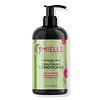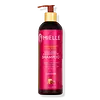What's inside
What's inside
 Benefits
Benefits

 Concerns
Concerns

 Ingredients Side-by-side
Ingredients Side-by-side

Water
Skin ConditioningCetearyl Alcohol
EmollientPolyquaternium-7
Caprylic/Capric Triglyceride
MaskingBehentrimonium Chloride
PreservativeC12-15 Alkyl Benzoate
AntimicrobialParfum
MaskingPersea Gratissima Oil
Skin ConditioningPPG-3 Myristyl Ether
EmollientBiotin
AntiseborrhoeicButyrospermum Parkii Butter
Skin ConditioningCocos Nucifera Oil
MaskingRosmarinus Officinalis Leaf Oil
MaskingMentha Piperita Oil
MaskingOlea Europaea Fruit Oil
MaskingPanthenol
Skin ConditioningBehentrimonium Methosulfate
Diheptyl Succinate
EmollientCapryloyl Glycerin/Sebacic Acid Copolymer
Skin ConditioningCetyl Alcohol
EmollientWater, Cetearyl Alcohol, Polyquaternium-7, Caprylic/Capric Triglyceride, Behentrimonium Chloride, C12-15 Alkyl Benzoate, Parfum, Persea Gratissima Oil, PPG-3 Myristyl Ether, Biotin, Butyrospermum Parkii Butter, Cocos Nucifera Oil, Rosmarinus Officinalis Leaf Oil, Mentha Piperita Oil, Olea Europaea Fruit Oil, Panthenol, Behentrimonium Methosulfate, Diheptyl Succinate, Capryloyl Glycerin/Sebacic Acid Copolymer, Cetyl Alcohol
Water
Skin ConditioningSodium C14-16 Olefin Sulfonate
CleansingCocamidopropyl Betaine
CleansingPolyquaternium-7
Disodium Cocoamphodipropionate
CleansingCocamide Mea
EmulsifyingGlycol Stearate
EmollientDisodium Lauryl Sulfosuccinate
CleansingParfum
MaskingHoney
HumectantPEG-150 Distearate
EmulsifyingPanthenol
Skin ConditioningHydrolyzed Wheat Protein
Skin ConditioningPunica Granatum Seed Oil
EmollientEuterpe Oleracea Fruit Extract
Glycerin
HumectantHydrolyzed Silk
HumectantOrbignya Oleifera Seed Oil
EmollientMauritia Flexuosa Fruit Oil
Skin ConditioningCopaifera Officinalis Resin
MaskingAstrocaryum Murumuru Seed Butter
EmollientSodium Chloride
MaskingCitric Acid
BufferingPhenoxyethanol
PreservativeBenzoic Acid
MaskingEthylhexylglycerin
Skin ConditioningGlycereth-2 Cocoate
EmulsifyingWater, Sodium C14-16 Olefin Sulfonate, Cocamidopropyl Betaine, Polyquaternium-7, Disodium Cocoamphodipropionate, Cocamide Mea, Glycol Stearate, Disodium Lauryl Sulfosuccinate, Parfum, Honey, PEG-150 Distearate, Panthenol, Hydrolyzed Wheat Protein, Punica Granatum Seed Oil, Euterpe Oleracea Fruit Extract, Glycerin, Hydrolyzed Silk, Orbignya Oleifera Seed Oil, Mauritia Flexuosa Fruit Oil, Copaifera Officinalis Resin, Astrocaryum Murumuru Seed Butter, Sodium Chloride, Citric Acid, Phenoxyethanol, Benzoic Acid, Ethylhexylglycerin, Glycereth-2 Cocoate
Ingredients Explained
These ingredients are found in both products.
Ingredients higher up in an ingredient list are typically present in a larger amount.
Panthenol is a common ingredient that helps hydrate and soothe the skin. It is found naturally in our skin and hair.
There are two forms of panthenol: D and L.
D-panthenol is also known as dexpanthenol. Most cosmetics use dexpanthenol or a mixture of D and L-panthenol.
Panthenol is famous due to its ability to go deeper into the skin's layers. Using this ingredient has numerous pros (and no cons):
Like hyaluronic acid, panthenol is a humectant. Humectants are able to bind and hold large amounts of water to keep skin hydrated.
This ingredient works well for wound healing. It works by increasing tissue in the wound and helps close open wounds.
Once oxidized, panthenol converts to pantothenic acid. Panthothenic acid is found in all living cells.
This ingredient is also referred to as pro-vitamin B5.
Learn more about PanthenolParfum is a catch-all term for an ingredient or more that is used to give a scent to products.
Also called "fragrance", this ingredient can be a blend of hundreds of chemicals or plant oils. This means every product with "fragrance" or "parfum" in the ingredients list is a different mixture.
For instance, Habanolide is a proprietary trade name for a specific aroma chemical. When used as a fragrance ingredient in cosmetics, most aroma chemicals fall under the broad labeling category of “FRAGRANCE” or “PARFUM” according to EU and US regulations.
The term 'parfum' or 'fragrance' is not regulated in many countries. In many cases, it is up to the brand to define this term.
For instance, many brands choose to label themselves as "fragrance-free" because they are not using synthetic fragrances. However, their products may still contain ingredients such as essential oils that are considered a fragrance by INCI standards.
One example is Calendula flower extract. Calendula is an essential oil that still imparts a scent or 'fragrance'.
Depending on the blend, the ingredients in the mixture can cause allergies and sensitivities on the skin. Some ingredients that are known EU allergens include linalool and citronellol.
Parfum can also be used to mask or cover an unpleasant scent.
The bottom line is: not all fragrances/parfum/ingredients are created equally. If you are worried about fragrances, we recommend taking a closer look at an ingredient. And of course, we always recommend speaking with a professional.
Learn more about ParfumPolyquaternium-7 is a light to clear colored liquid. It is commonly found in haircare products for its film-forming and anti-static properties.
According to a manufacturer, it is a non-paraben and specially developed for negatively charged surfactant systems. This makes it a great hairstyle holder and helps to improve wet hair detangling without adding buildup.
Water. It's the most common cosmetic ingredient of all. You'll usually see it at the top of ingredient lists, meaning that it makes up the largest part of the product.
So why is it so popular? Water most often acts as a solvent - this means that it helps dissolve other ingredients into the formulation.
You'll also recognize water as that liquid we all need to stay alive. If you see this, drink a glass of water. Stay hydrated!
Learn more about Water